Tanenbaum A. Computer Networks
Подождите немного. Документ загружается.

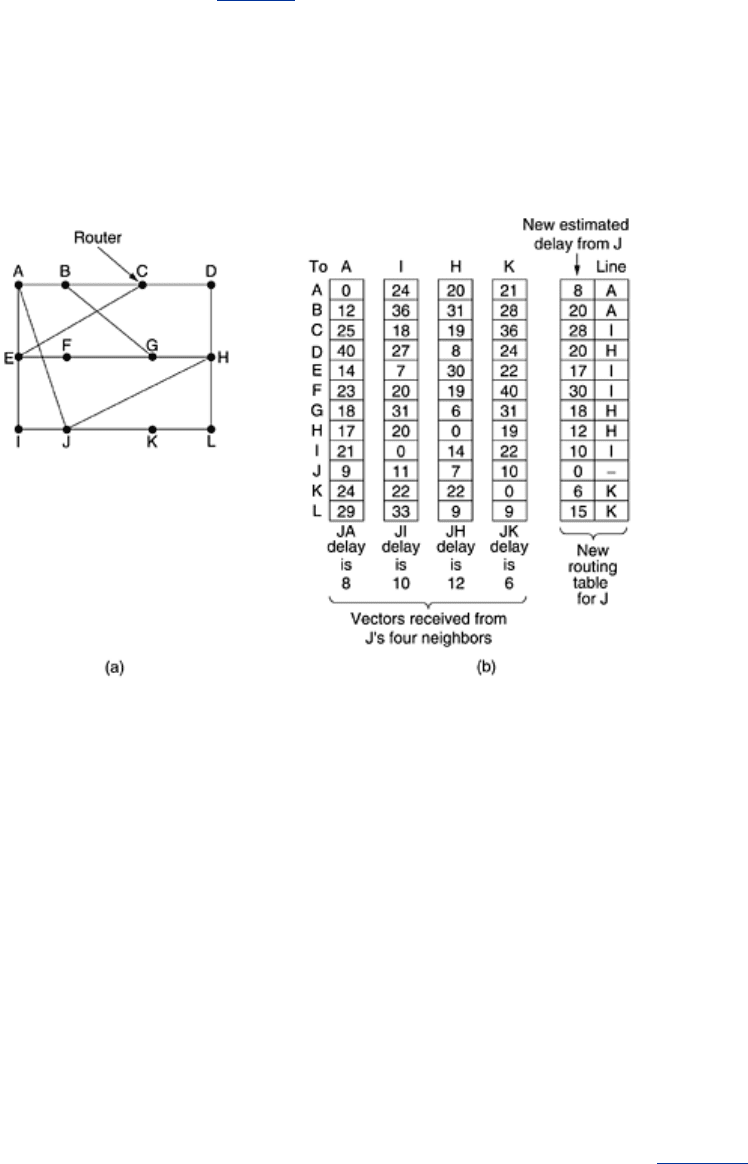
corresponding line in its new routing table. Note that the old routing table is not used in the
calculation.
This updating process is illustrated in
Fig. 5-9. Part (a) shows a subnet. The first four columns
of part (b) show the delay vectors received from the neighbors of router
J. A claims to have a
12-msec delay to
B, a 25-msec delay to C, a 40-msec delay to D, etc. Suppose that J has
measured or estimated its delay to its neighbors,
A, I, H, and K as 8, 10, 12, and 6 msec,
respectively.
Figure 5-9. (a) A subnet. (b) Input from A, I, H, K, and the new routing
table for
J.
Consider how
J computes its new route to router G. It knows that it can get to A in 8 msec,
and
A claims to be able to get to G in 18 msec, so J knows it can count on a delay of 26 msec
to
G if it forwards packets bound for G to A. Similarly, it computes the delay to G via I, H, and
K as 41 (31 + 10), 18 (6 + 12), and 37 (31 + 6) msec, respectively. The best of these values
is 18, so it makes an entry in its routing table that the delay to
G is 18 msec and that the
route to use is via
H. The same calculation is performed for all the other destinations, with the
new routing table shown in the last column of the figure.
The Count-to-Infinity Problem
Distance vector routing works in theory but has a serious drawback in practice: although it
converges to the correct answer, it may do so slowly. In particular, it reacts rapidly to good
news, but leisurely to bad news. Consider a router whose best route to destination
X is large.
If on the next exchange neighbor
A suddenly reports a short delay to X, the router just
switches over to using the line to
A to send traffic to X. In one vector exchange, the good news
is processed.
To see how fast good news propagates, consider the five-node (linear) subnet of
Fig. 5-10,
where the delay metric is the number of hops. Suppose
A is down initially and all the other
routers know this. In other words, they have all recorded the delay to
A as infinity.
Figure 5-10. The count-to-infinity problem.
271
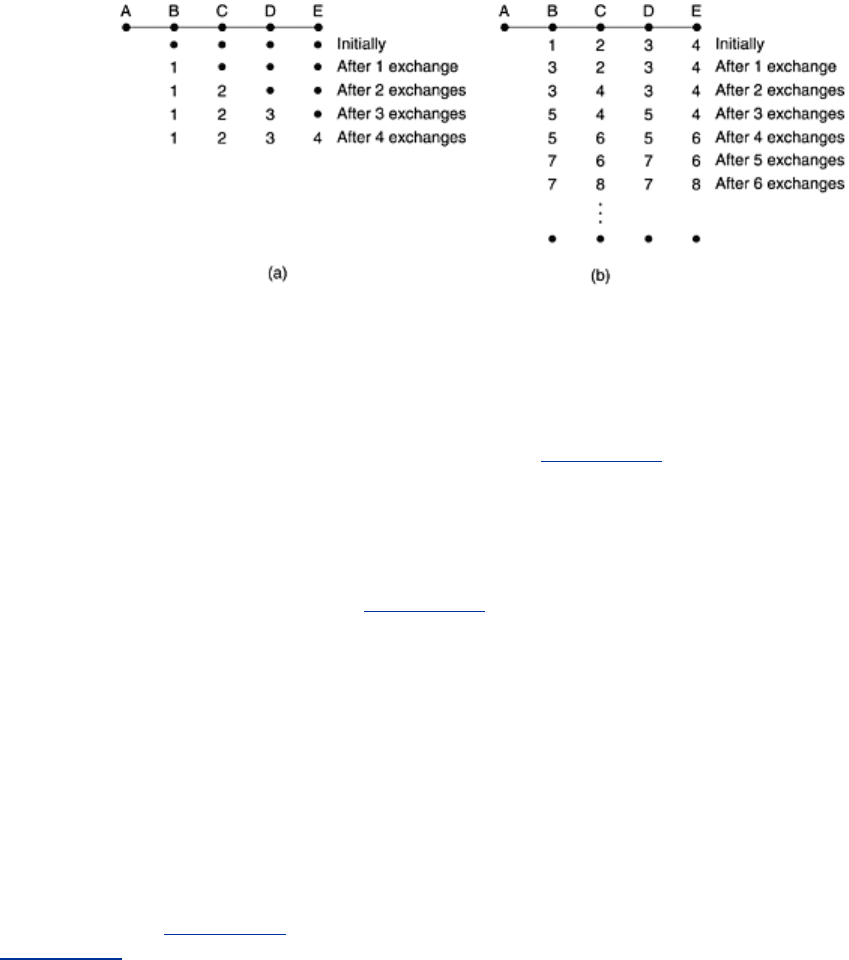
When
A comes up, the other routers learn about it via the vector exchanges. For simplicity we
will assume that there is a gigantic gong somewhere that is struck periodically to initiate a
vector exchange at all routers simultaneously. At the time of the first exchange,
B learns that
its left neighbor has zero delay to
A. B now makes an entry in its routing table that A is one
hop away to the left. All the other routers still think that
A is down. At this point, the routing
table entries for
A are as shown in the second row of Fig. 5-10(a). On the next exchange, C
learns that
B has a path of length 1 to A, so it updates its routing table to indicate a path of
length 2, but
D and E do not hear the good news until later. Clearly, the good news is
spreading at the rate of one hop per exchange. In a subnet whose longest path is of length
N
hops, within
N exchanges everyone will know about newly-revived lines and routers.
Now let us consider the situation of
Fig. 5-10(b), in which all the lines and routers are initially
up. Routers
B, C, D, and E have distances to A of 1, 2, 3, and 4, respectively. Suddenly A goes
down, or alternatively, the line between
A and B is cut, which is effectively the same thing
from
B's point of view.
At the first packet exchange,
B does not hear anything from A. Fortunately, C says: Do not
worry; I have a path to
A of length 2. Little does B know that C's path runs through B itself.
For all
B knows, C might have ten lines all with separate paths to A of length 2. As a result, B
thinks it can reach
A via C, with a path length of 3. D and E do not update their entries for A
on the first exchange.
On the second exchange,
C notices that each of its neighbors claims to have a path to A of
length 3. It picks one of the them at random and makes its new distance to
A 4, as shown in
the third row of
Fig. 5-10(b). Subsequent exchanges produce the history shown in the rest of
Fig. 5-10(b).
From this figure, it should be clear why bad news travels slowly: no router ever has a value
more than one higher than the minimum of all its neighbors. Gradually, all routers work their
way up to infinity, but the number of exchanges required depends on the numerical value used
for infinity. For this reason, it is wise to set infinity to the longest path plus 1. If the metric is
time delay, there is no well-defined upper bound, so a high value is needed to prevent a path
with a long delay from being treated as down. Not entirely surprisingly, this problem is known
as the
count-to-infinity problem. There have been a few attempts to solve it (such as split
horizon with poisoned reverse in RFC 1058), but none of these work well in general. The core
of the problem is that when
X tells Y that it has a path somewhere, Y has no way of knowing
whether it itself is on the path.
5.2.5 Link State Routing
Distance vector routing was used in the ARPANET until 1979, when it was replaced by link
state routing. Two primary problems caused its demise. First, since the delay metric was
queue length, it did not take line bandwidth into account when choosing routes. Initially, all
the lines were 56 kbps, so line bandwidth was not an issue, but after some lines had been
272
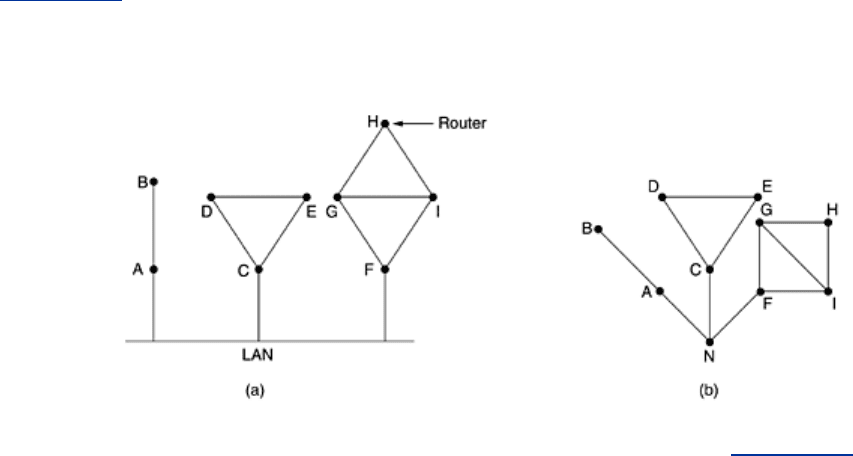
upgraded to 230 kbps and others to 1.544 Mbps, not taking bandwidth into account was a
major problem. Of course, it would have been possible to change the delay metric to factor in
line bandwidth, but a second problem also existed, namely, the algorithm often took too long
to converge (the count-to-infinity problem). For these reasons, it was replaced by an entirely
new algorithm, now called
link state routing. Variants of link state routing are now widely
used.
The idea behind link state routing is simple and can be stated as five parts. Each router must
do the following:
1. Discover its neighbors and learn their network addresses.
2. Measure the delay or cost to each of its neighbors.
3. Construct a packet telling all it has just learned.
4. Send this packet to all other routers.
5. Compute the shortest path to every other router.
In effect, the complete topology and all delays are experimentally measured and distributed to
every router. Then Dijkstra's algorithm can be run to find the shortest path to every other
router. Below we will consider each of these five steps in more detail.
Learning about the Neighbors
When a router is booted, its first task is to learn who its neighbors are. It accomplishes this
goal by sending a special HELLO packet on each point-to-point line. The router on the other
end is expected to send back a reply telling who it is. These names must be globally unique
because when a distant router later hears that three routers are all connected to
F, it is
essential that it can determine whether all three mean the same
F.
When two or more routers are connected by a LAN, the situation is slightly more complicated.
Fig. 5-11(a) illustrates a LAN to which three routers, A, C, and F, are directly connected. Each
of these routers is connected to one or more additional routers, as shown.
Figure 5-11. (a) Nine routers and a LAN. (b) A graph model of (a).
One way to model the LAN is to consider it as a node itself, as shown in
Fig. 5-11(b). Here we
have introduced a new, artificial node,
N, to which A, C, and F are connected. The fact that it is
possible to go from
A to C on the LAN is represented by the path ANC here.
Measuring Line Cost
The link state routing algorithm requires each router to know, or at least have a reasonable
estimate of, the delay to each of its neighbors. The most direct way to determine this delay is
to send over the line a special ECHO packet that the other side is required to send back
273
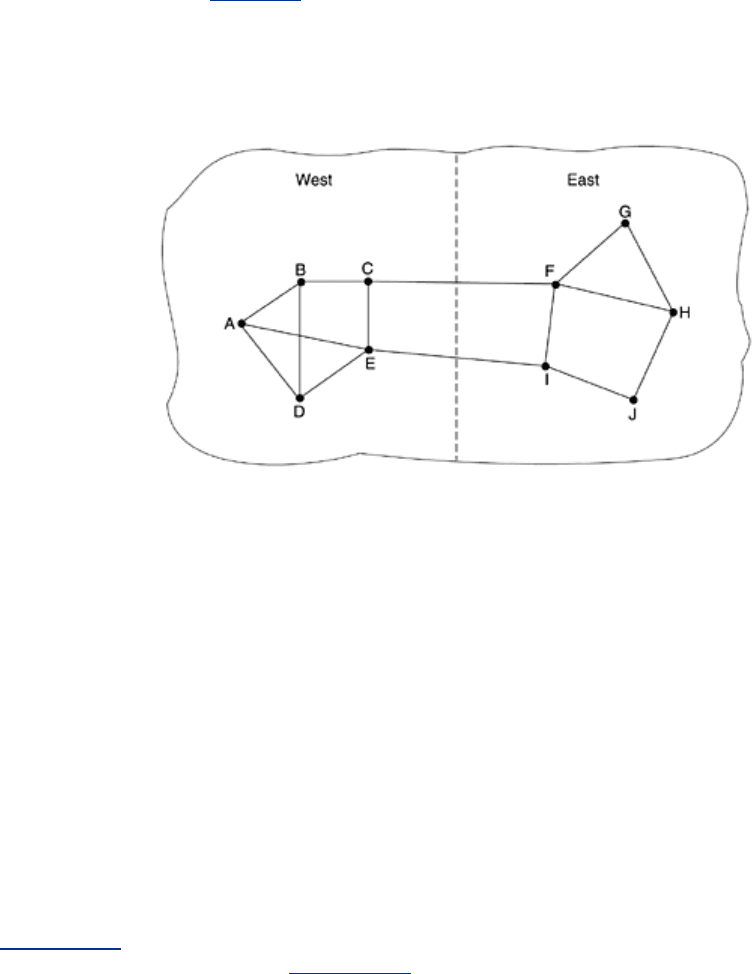
immediately. By measuring the round-trip time and dividing it by two, the sending router can
get a reasonable estimate of the delay. For even better results, the test can be conducted
several times, and the average used. Of course, this method implicitly assumes the delays are
symmetric, which may not always be the case.
An interesting issue is whether to take the load into account when measuring the delay. To
factor the load in, the round-trip timer must be started when the ECHO packet is queued. To
ignore the load, the timer should be started when the ECHO packet reaches the front of the
queue.
Arguments can be made both ways. Including traffic-induced delays in the measurements
means that when a router has a choice between two lines with the same bandwidth, one of
which is heavily loaded all the time and one of which is not, the router will regard the route
over the unloaded line as a shorter path. This choice will result in better performance.
Unfortunately, there is also an argument against including the load in the delay calculation.
Consider the subnet of
Fig. 5-12, which is divided into two parts, East and West, connected by
two lines,
CF and EI.
Figure 5-12. A subnet in which the East and West parts are connected
by two lines.
Suppose that most of the traffic between East and West is using line
CF, and as a result, this
line is heavily loaded with long delays. Including queueing delay in the shortest path
calculation will make
EI more attractive. After the new routing tables have been installed, most
of the East-West traffic will now go over
EI, overloading this line. Consequently, in the next
update,
CF will appear to be the shortest path. As a result, the routing tables may oscillate
wildly, leading to erratic routing and many potential problems. If load is ignored and only
bandwidth is considered, this problem does not occur. Alternatively, the load can be spread
over both lines, but this solution does not fully utilize the best path. Nevertheless, to avoid
oscillations in the choice of best path, it may be wise to distribute the load over multiple lines,
with some known fraction going over each line.
Building Link State Packets
Once the information needed for the exchange has been collected, the next step is for each
router to build a packet containing all the data. The packet starts with the identity of the
sender, followed by a sequence number and age (to be described later), and a list of
neighbors. For each neighbor, the delay to that neighbor is given. An example subnet is given
in
Fig. 5-13(a) with delays shown as labels on the lines. The corresponding link state packets
for all six routers are shown in
Fig. 5-13(b).
274

Figure 5-13. (a) A subnet. (b) The link state packets for this subnet.
Building the link state packets is easy. The hard part is determining when to build them. One
possibility is to build them periodically, that is, at regular intervals. Another possibility is to
build them when some significant event occurs, such as a line or neighbor going down or
coming back up again or changing its properties appreciably.
Distributing the Link State Packets
The trickiest part of the algorithm is distributing the link state packets reliably. As the packets
are distributed and installed, the routers getting the first ones will change their routes.
Consequently, the different routers may be using different versions of the topology, which can
lead to inconsistencies, loops, unreachable machines, and other problems.
First we will describe the basic distribution algorithm. Later we will give some refinements. The
fundamental idea is to use flooding to distribute the link state packets. To keep the flood in
check, each packet contains a sequence number that is incremented for each new packet sent.
Routers keep track of all the (source router, sequence) pairs they see. When a new link state
packet comes in, it is checked against the list of packets already seen. If it is new, it is
forwarded on all lines except the one it arrived on. If it is a duplicate, it is discarded. If a
packet with a sequence number lower than the highest one seen so far ever arrives, it is
rejected as being obsolete since the router has more recent data.
This algorithm has a few problems, but they are manageable. First, if the sequence numbers
wrap around, confusion will reign. The solution here is to use a 32-bit sequence number. With
one link state packet per second, it would take 137 years to wrap around, so this possibility
can be ignored.
Second, if a router ever crashes, it will lose track of its sequence number. If it starts again at
0, the next packet will be rejected as a duplicate.
Third, if a sequence number is ever corrupted and 65,540 is received instead of 4 (a 1-bit
error), packets 5 through 65,540 will be rejected as obsolete, since the current sequence
number is thought to be 65,540.
The solution to all these problems is to include the age of each packet after the sequence
number and decrement it once per second. When the age hits zero, the information from that
router is discarded. Normally, a new packet comes in, say, every 10 sec, so router information
only times out when a router is down (or six consecutive packets have been lost, an unlikely
event). The
Age field is also decremented by each router during the initial flooding process, to
make sure no packet can get lost and live for an indefinite period of time (a packet whose age
is zero is discarded).
Some refinements to this algorithm make it more robust. When a link state packet comes in to
a router for flooding, it is not queued for transmission immediately. Instead it is first put in a
holding area to wait a short while. If another link state packet from the same source comes in
before the first packet is transmitted, their sequence numbers are compared. If they are equal,
275
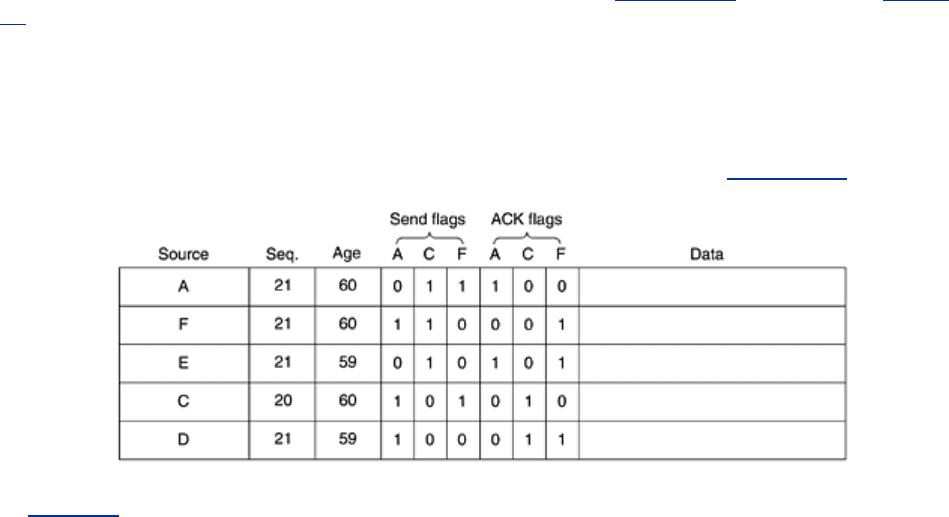
the duplicate is discarded. If they are different, the older one is thrown out. To guard against
errors on the router-router lines, all link state packets are acknowledged. When a line goes
idle, the holding area is scanned in round-robin order to select a packet or acknowledgement
to send.
The data structure used by router
B for the subnet shown in Fig. 5-13(a) is depicted in Fig. 5-
14. Each row here corresponds to a recently-arrived, but as yet not fully-processed, link state
packet. The table records where the packet originated, its sequence number and age, and the
data. In addition, there are send and acknowledgement flags for each of
B's three lines (to A,
C, and F, respectively). The send flags mean that the packet must be sent on the indicated
line. The acknowledgement flags mean that it must be acknowledged there.
Figure 5-14. The packet buffer for router B in Fig. 5-13.
In
Fig. 5-14, the link state packet from A arrives directly, so it must be sent to C and F and
acknowledged to
A, as indicated by the flag bits. Similarly, the packet from F has to be
forwarded to
A and C and acknowledged to F.
However, the situation with the third packet, from
E, is different. It arrived twice, once via EAB
and once via
EFB. Consequently, it has to be sent only to C but acknowledged to both A and F,
as indicated by the bits.
If a duplicate arrives while the original is still in the buffer, bits have to be changed. For
example, if a copy of
C's state arrives from F before the fourth entry in the table has been
forwarded, the six bits will be changed to 100011 to indicate that the packet must be
acknowledged to
F but not sent there.
Computing the New Routes
Once a router has accumulated a full set of link state packets, it can construct the entire
subnet graph because every link is represented. Every link is, in fact, represented twice, once
for each direction. The two values can be averaged or used separately.
Now Dijkstra's algorithm can be run locally to construct the shortest path to all possible
destinations. The results of this algorithm can be installed in the routing tables, and normal
operation resumed.
For a subnet with
n routers, each of which has k neighbors, the memory required to store the
input data is proportional to
kn. For large subnets, this can be a problem. Also, the
computation time can be an issue. Nevertheless, in many practical situations, link state routing
works well.
However, problems with the hardware or software can wreak havoc with this algorithm (also
with other ones). For example, if a router claims to have a line it does not have or forgets a
line it does have, the subnet graph will be incorrect. If a router fails to forward packets or
276

corrupts them while forwarding them, trouble will arise. Finally, if it runs out of memory or
does the routing calculation wrong, bad things will happen. As the subnet grows into the range
of tens or hundreds of thousands of nodes, the probability of some router failing occasionally
becomes nonnegligible. The trick is to try to arrange to limit the damage when the inevitable
happens. Perlman (1988) discusses these problems and their solutions in detail.
Link state routing is widely used in actual networks, so a few words about some example
protocols using it are in order. The OSPF protocol, which is widely used in the Internet, uses a
link state algorithm. We will describe OSPF in
Sec. 5.6.4.
Another link state protocol is
IS-IS (Intermediate System-Intermediate System), which
was designed for DECnet and later adopted by ISO for use with its connectionless network
layer protocol, CLNP. Since then it has been modified to handle other protocols as well, most
notably, IP. IS-IS is used in some Internet backbones (including the old NSFNET backbone)
and in some digital cellular systems such as CDPD. Novell NetWare uses a minor variant of IS-
IS (NLSP) for routing IPX packets.
Basically IS-IS distributes a picture of the router topology, from which the shortest paths are
computed. Each router announces, in its link state information, which network layer addresses
it can reach directly. These addresses can be IP, IPX, AppleTalk, or any other addresses. IS-IS
can even support multiple network layer protocols at the same time.
Many of the innovations designed for IS-IS were adopted by OSPF (OSPF was designed several
years after IS-IS). These include a self-stabilizing method of flooding link state updates, the
concept of a designated router on a LAN, and the method of computing and supporting path
splitting and multiple metrics. As a consequence, there is very little difference between IS-IS
and OSPF. The most important difference is that IS-IS is encoded in such a way that it is easy
and natural to simultaneously carry information about multiple network layer protocols, a
feature OSPF does not have. This advantage is especially valuable in large multiprotocol
environments.
5.2.6 Hierarchical Routing
As networks grow in size, the router routing tables grow proportionally. Not only is router
memory consumed by ever-increasing tables, but more CPU time is needed to scan them and
more bandwidth is needed to send status reports about them. At a certain point the network
may grow to the point where it is no longer feasible for every router to have an entry for every
other router, so the routing will have to be done hierarchically, as it is in the telephone
network.
When hierarchical routing is used, the routers are divided into what we will call
regions, with
each router knowing all the details about how to route packets to destinations within its own
region, but knowing nothing about the internal structure of other regions. When different
networks are interconnected, it is natural to regard each one as a separate region in order to
free the routers in one network from having to know the topological structure of the other
ones.
For huge networks, a two-level hierarchy may be insufficient; it may be necessary to group the
regions into clusters, the clusters into zones, the zones into groups, and so on, until we run
out of names for aggregations. As an example of a multilevel hierarchy, consider how a packet
might be routed from Berkeley, California, to Malindi, Kenya. The Berkeley router would know
the detailed topology within California but would send all out-of-state traffic to the Los Angeles
router. The Los Angeles router would be able to route traffic to other domestic routers but
would send foreign traffic to New York. The New York router would be programmed to direct all
traffic to the router in the destination country responsible for handling foreign traffic, say, in
Nairobi. Finally, the packet would work its way down the tree in Kenya until it got to Malindi.
277
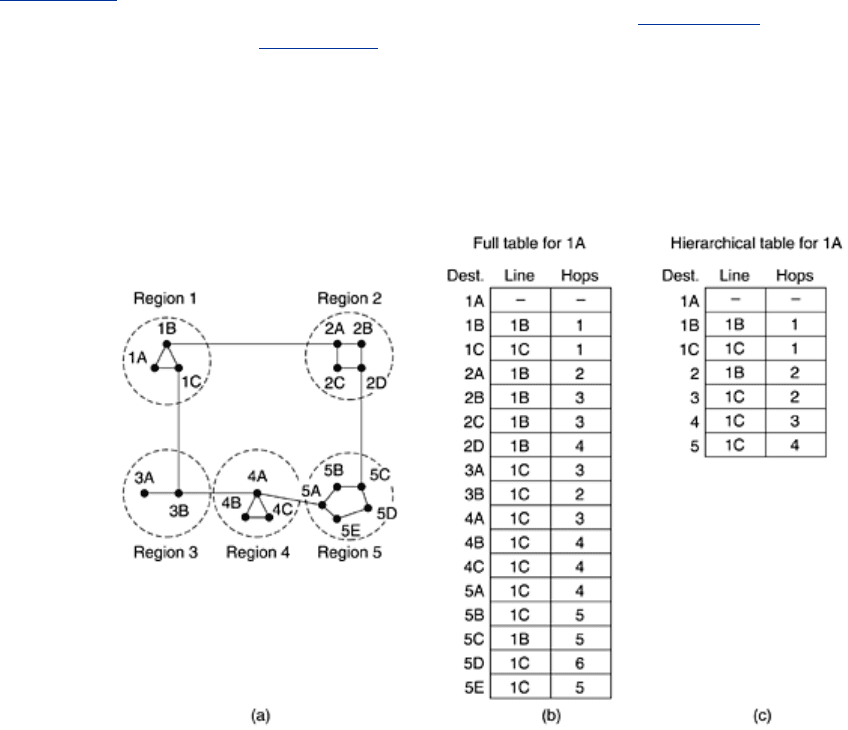
Figure 5-15 gives a quantitative example of routing in a two-level hierarchy with five regions.
The full routing table for router 1
A has 17 entries, as shown in Fig. 5-15(b). When routing is
done hierarchically, as in
Fig. 5-15(c), there are entries for all the local routers as before, but
all other regions have been condensed into a single router, so all traffic for region 2 goes via
the 1
B -2A line, but the rest of the remote traffic goes via the 1C -3B line. Hierarchical routing
has reduced the table from 17 to 7 entries. As the ratio of the number of regions to the
number of routers per region grows, the savings in table space increase.
Figure 5-15. Hierarchical routing.
Unfortunately, these gains in space are not free. There is a penalty to be paid, and this penalty
is in the form of increased path length. For example, the best route from 1
A to 5C is via region
2, but with hierarchical routing all traffic to region 5 goes via region 3, because that is better
for most destinations in region 5.
When a single network becomes very large, an interesting question is: How many levels should
the hierarchy have? For example, consider a subnet with 720 routers. If there is no hierarchy,
each router needs 720 routing table entries. If the subnet is partitioned into 24 regions of 30
routers each, each router needs 30 local entries plus 23 remote entries for a total of 53
entries. If a three-level hierarchy is chosen, with eight clusters, each containing 9 regions of
10 routers, each router needs 10 entries for local routers, 8 entries for routing to other regions
within its own cluster, and 7 entries for distant clusters, for a total of 25 entries. Kamoun and
Kleinrock (1979) discovered that the optimal number of levels for an
N router subnet is ln N,
requiring a total of
e ln N entries per router. They have also shown that the increase in
effective mean path length caused by hierarchical routing is sufficiently small that it is usually
acceptable.
5.2.7 Broadcast Routing
In some applications, hosts need to send messages to many or all other hosts. For example, a
service distributing weather reports, stock market updates, or live radio programs might work
best by broadcasting to all machines and letting those that are interested read the data.
Sending a packet to all destinations simultaneously is called
broadcasting; various methods
have been proposed for doing it.
278

One broadcasting method that requires no special features from the subnet is for the source to
simply send a distinct packet to each destination. Not only is the method wasteful of
bandwidth, but it also requires the source to have a complete list of all destinations. In practice
this may be the only possibility, but it is the least desirable of the methods.
Flooding is another obvious candidate. Although flooding is ill-suited for ordinary point-to-point
communication, for broadcasting it might rate serious consideration, especially if none of the
methods described below are applicable. The problem with flooding as a broadcast technique is
the same problem it has as a point-to-point routing algorithm: it generates too many packets
and consumes too much bandwidth.
A third algorithm is
multidestination routing. If this method is used, each packet contains
either a list of destinations or a bit map indicating the desired destinations. When a packet
arrives at a router, the router checks all the destinations to determine the set of output lines
that will be needed. (An output line is needed if it is the best route to at least one of the
destinations.) The router generates a new copy of the packet for each output line to be used
and includes in each packet only those destinations that are to use the line. In effect, the
destination set is partitioned among the output lines. After a sufficient number of hops, each
packet will carry only one destination and can be treated as a normal packet. Multidestination
routing is like separately addressed packets, except that when several packets must follow the
same route, one of them pays full fare and the rest ride free.
A fourth broadcast algorithm makes explicit use of the sink tree for the router initiating the
broadcast—or any other convenient spanning tree for that matter. A
spanning tree is a
subset of the subnet that includes all the routers but contains no loops. If each router knows
which of its lines belong to the spanning tree, it can copy an incoming broadcast packet onto
all the spanning tree lines except the one it arrived on. This method makes excellent use of
bandwidth, generating the absolute minimum number of packets necessary to do the job. The
only problem is that each router must have knowledge of some spanning tree for the method
to be applicable. Sometimes this information is available (e.g., with link state routing) but
sometimes it is not (e.g., with distance vector routing).
Our last broadcast algorithm is an attempt to approximate the behavior of the previous one,
even when the routers do not know anything at all about spanning trees. The idea, called
reverse path forwarding, is remarkably simple once it has been pointed out. When a
broadcast packet arrives at a router, the router checks to see if the packet arrived on the line
that is normally used for sending packets
to the source of the broadcast. If so, there is an
excellent chance that the broadcast packet itself followed the best route from the router and is
therefore the first copy to arrive at the router. This being the case, the router forwards copies
of it onto all lines except the one it arrived on. If, however, the broadcast packet arrived on a
line other than the preferred one for reaching the source, the packet is discarded as a likely
duplicate.
An example of reverse path forwarding is shown in
Fig. 5-16. Part (a) shows a subnet, part (b)
shows a sink tree for router
I of that subnet, and part (c) shows how the reverse path
algorithm works. On the first hop,
I sends packets to F, H, J, and N, as indicated by the second
row of the tree. Each of these packets arrives on the preferred path to
I (assuming that the
preferred path falls along the sink tree) and is so indicated by a circle around the letter. On the
second hop, eight packets are generated, two by each of the routers that received a packet on
the first hop. As it turns out, all eight of these arrive at previously unvisited routers, and five of
these arrive along the preferred line. Of the six packets generated on the third hop, only three
arrive on the preferred path (at
C, E, and K); the others are duplicates. After five hops and 24
packets, the broadcasting terminates, compared with four hops and 14 packets had the sink
tree been followed exactly.
Figure 5-16. Reverse path forwarding. (a) A subnet. (b) A sink tree.
(c) The tree built by reverse path forwarding.
279

The principal advantage of reverse path forwarding is that it is both reasonably efficient and
easy to implement. It does not require routers to know about spanning trees, nor does it have
the overhead of a destination list or bit map in each broadcast packet as does multidestination
addressing. Nor does it require any special mechanism to stop the process, as flooding does
(either a hop counter in each packet and a priori knowledge of the subnet diameter, or a list of
packets already seen per source).
5.2.8 Multicast Routing
Some applications require that widely-separated processes work together in groups, for
example, a group of processes implementing a distributed database system. In these
situations, it is frequently necessary for one process to send a message to all the other
members of the group. If the group is small, it can just send each other member a point-to-
point message. If the group is large, this strategy is expensive. Sometimes broadcasting can
be used, but using broadcasting to inform 1000 machines on a million-node network is
inefficient because most receivers are not interested in the message (or worse yet, they are
definitely interested but are not supposed to see it). Thus, we need a way to send messages to
well-defined groups that are numerically large in size but small compared to the network as a
whole.
Sending a message to such a group is called
multicasting, and its routing algorithm is called
multicast routing. In this section we will describe one way of doing multicast routing. For
additional information, see (Chu et al., 2000; Costa et al. 2001; Kasera et al., 2000; Madruga
and Garcia-Luna-Aceves, 2001; Zhang and Ryu, 2001).
Multicasting requires group management. Some way is needed to create and destroy groups,
and to allow processes to join and leave groups. How these tasks are accomplished is not of
concern to the routing algorithm. What is of concern is that when a process joins a group, it
informs its host of this fact. It is important that routers know which of their hosts belong to
which groups. Either hosts must inform their routers about changes in group membership, or
routers must query their hosts periodically. Either way, routers learn about which of their hosts
are in which groups. Routers tell their neighbors, so the information propagates through the
subnet.
To do multicast routing, each router computes a spanning tree covering all other routers. For
example, in
Fig. 5-17(a) we have two groups, 1 and 2. Some routers are attached to hosts
that belong to one or both of these groups, as indicated in the figure. A spanning tree for the
leftmost router is shown in
Fig. 5-17(b).
Figure 5-17. (a) A network. (b) A spanning tree for the leftmost
router. (c) A multicast tree for group 1. (d) A multicast tree for group
2.
280
